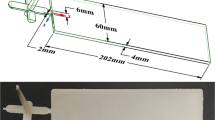Abstract
In part 2 of the paper simplified unsteady-mass (and momentum-) balance equations of melt polymer resin in the cavities of GAIM were proposed, as a time-dependent rule of thumb, to constitute a novel flow model in GAIM under the configuration of two fan-shaped geometries connected with a gas nozzle. Upon performing a simulation on them with commercial software (MOLDFLOW), we compared the time evolution of simulated gas penetration lengths with the those of unsteady trajectory on the gas flow in GAIM by the suggested novel flow model in the fan-shaped cavities in order to check the precision of model-predicted gas penetration lengths as well as the consistency of its predicted direction. The results by the suggested novel flow model were satisfactory to fit the trajectory simulated with commercial software (MOLDFLOW).
Similar content being viewed by others
References
Chen, S.-C., Cheng, N.-T. and Hsu, K.-S., “Simulations and Verification of the Secondary Gas Penetration in a Gas Assisted Injection Molded Spiral Tube,”International Communications in Heat and Mass Transfer,22, 319 (1995)
Chen, S.-C., Cheng, N.-T. and Hsu, K.-S., “Simulations of Gas Penetration in Thin Plates Designed with a Semicircular Gas Channel During Gas Assisted Injection Molding,”Int. J. Mech. Sci.,38, 335 (1996a).
Chen, S.-C., Cheng, N.-T. and Hsu, K.-S., “Polymer Melt Flow and Gas Penetration in Gas Assisted Molding of a Thin Part with Gas Channel Design,”Int. J. Heat Mass Transfer,39, 2957 (1996b).
Chen, S.-C., Cheng, N.-T. and Chao, S.-M., “Simulations and Verification of Melt Flow and Secondary Gas Penetration During a Gas Assisted Injection Molding,”International Polymer Processing,14, 90 (1998).
Gao, D. M., Nguyen, K. T., Garcia-Rejon, Salloum, G., “Optimization of the Gas Assisted Injection Moulding Process Using Multiple Gas-injection Systems,”Journal of Materials Processing Technology,69, 282 (1997).
Gauri, V. G. and Koelling, K.W., “Gas-assisted Displacement of Viscoelastic Fluids: Flow Dynamics at the Bubble Front,”J. Non-Newtonian Fluid Mech.,83, 183 (1999).
Huzyak, P. C. and Koelling, K.W., “The Penetration of a Long Bubble through a Viscoelastic Fluid in a Tube,”J. Non-Newtonian Fluid Mech.,71, 73 (1997).
Khayat, R. E., Derdouri, A. and Herbert, L. P., “A Three-dimensional Boundary-element Approach to Gas Assisted Injection Molding,”J. Non-Newtonian Fluid Mech.,57, 253 (1995).
Kolb, W. B. and Cerro, R. L., “Coating the Inside of a Capillary of Square Cross Section,”Chem. Eng. Sci.,46(9), 2181 (1991).
Lim, K. H. and Lee, E. J., “Prediction of Gas Flow Directions in Gas Assisted Injection Molding When Cavities and Runners are Involved,”Korean J. Chem. Eng.,20, 592 (2003).
Lim, K. H. and Soh, Y. S., “The Diagnosis of Flow Direction Under fan Shaped Geometry in Gas Assisted Injection Molding,”Journal of Injection Molding Technology,3, 31 (1999).
Lim, K. H., “Flow Direction When Fan Shaped Geometry is Applied in Gas-Assisted Injection Molding: 1. Flow Model Theory and its Criteria for Predicting Flow Directions,”Korean J. Chem. Eng.,21, 48 (2004).
McCabe, W. L., Smith, J. C. and Harriot, P., “Unit Operations of Chemical Engineering,” 4th Ed., McGraw-Hill Press (1986).
Parez, M.A., Ong, N. S., Lam, Y. C. and Tor, S. B., “Gas-assisted Injection Molding: the Effects of Process Variables and Gas Channel Geometry,”Journal of Material processing Technology,121, 27 (2002).
Poslinski, A. J., Oehler, P.R. and Stokes, V. K., “Isothermal Gas-assisted Displacement of vIscoplastic Liquids in Tubes,”Polym. Eng. Sci.,35, 877 (1995).
Shen, Y. K., “Study on the Gas-liquid Interface and Polymer Melt Front in Gas Assisted Injection Molding,”Int. Comm. Heat Mass Transfer,24, 295 (1997).
Shen, Y. K., “Study on Polymer Melt Front, Gas Front and Solid Layer in Filling Stage of Gas Assisted Injection Molding,”Int. Comm. Heat Mass Transfer,28, 139 (2001).
Soh, Y. S. and Lim, K. H., “Control of Gas Direction in Gas Assisted Injection Molding; Definition of Resistance to Velocity, rv,” SPE ANTEC Tec. Papers,60, 482 (2002).
Author information
Authors and Affiliations
Corresponding author
Rights and permissions
About this article
Cite this article
Lim, KH., Hong, S.H. Flow direction when fan shaped geometry is applied in gas-assisted injection molding: 2. Development of flow model and its predictions. Korean J. Chem. Eng. 21, 59–68 (2004). https://doi.org/10.1007/BF02705381
Received:
Accepted:
Issue Date:
DOI: https://doi.org/10.1007/BF02705381




